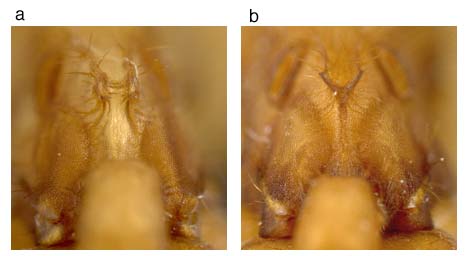
| Genus List | Genus Overview | Species List |
Color coding:
In Costa Rica, a certain level of identification can be done in the field based on color and location.
hamatum: uniform orange; widespread.
lucanoides: uniform orange; Atlantic slope and montane areas, difficult to distinguish from hamatum in the field.
burchellii parvispinum: minor workers entirely black, majors with black metasoma grading to yellow white head; montane areas and all of Pacific slope, sharply parapatric with burchellii foreli.
burchellii foreli: minor workers with black head and mesosoma, reddish brown metasoma; majors with yellow white head, darker mesosoma, and reddish brown metasoma; mid to lower elevation Atlantic slope, sharply parapatric with burchellii parvispinum.
mexicanum: maroon, metasoma lighter than mesosoma and head; widespread.
vagans angustatum: maroon, metasoma lighter than mesosoma and head; widespread.
dulcium crassinode: maroon, metasoma lighter than mesosoma and head; southern Pacific lowlands.
Technical key:
10a. Propodeal teeth spiniform; occipital teeth very small or absent; petiole of minor workers with elevated anterodorsal flange; fourth abdominal tergite with dense appressed pubescence beneath erect setae; color dark maroon with lighter maroon metasoma: dulcium crassinode
10b. Propodeal teeth shorter, more in the form of angular flanges; occipital teeth weakly to strongly developed; anterodorsal petiolar flange present or absent; fourth abdominal tergite with short, dilute pubescence beneath erect setae: 20

20a. Petiole in lateral view low and elongate, subrectangular, lacking an elevated anterodorsal flange: 30
20b. Petiole in lateral view shorter, more hump-shaped, with or without anterodorsal flange: 50

30a. When propodeum viewed from the rear, bases of propodeal teeth are separated, extending to a variable extent onto the posterior face as separate, short weak carinae; color orange yellow; face of major polished and shiny; sickle-shape mandible of major never with broad tooth along inner margin: hamatum
30b. When propodeum viewed from the rear, bases of propodeal teeth converge and form a single strong carina that extends onto the posterior face of propodeum, forming a Y-shaped structure; color orange yellow or maroon; face of major matte; mandible of major with or without tooth on inner margin: 40

40a. Color orange yellow; sickle-shaped mandible of major with broad tooth at midlength of inner margin: lucanoides
40b. Color maroon; mandible of major lacking tooth on inner margin: mexicanum

50a. Petiole in lateral view with elevated anterodorsal flange; color maroon: vagans angustatum
50b. Petiole in lateral view lacking elevated flange; head black or yellow white, mesosoma black or dusky yellow white, metasoma black or maroon: 60

60a. Metasoma black: burchellii parvispinum
60b. Metasoma maroon: burchellii foreli

Page author:
John T. Longino, The Evergreen State College, Olympia WA 98505 USA.longinoj@evergreen.edu